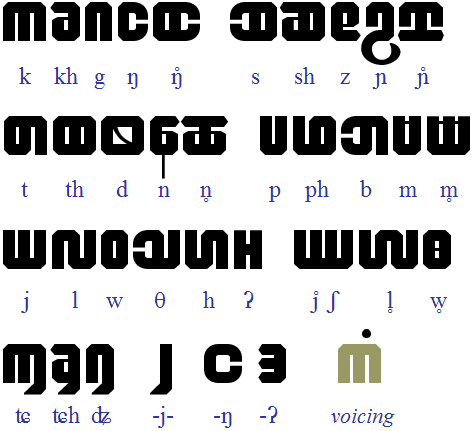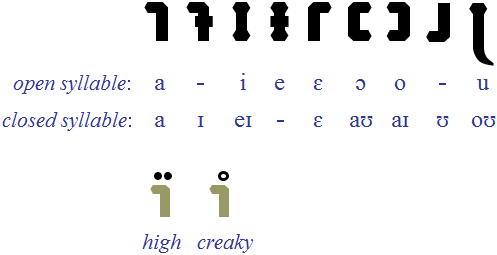This script is an attempt to capture the phonology of Burmese in a highly simplified Burmic style. Written Burmese is quite an attractive script (and ancient examples are rather beautiful) but is currently inconsistent with common speech. The NeoMon script seeks to represent modern standard spoken Burmese in a phonetic manner, while still retaining generic Burmese/Mon letter shapes, and some reference to old spelling rules where this helps simplify the writing. The overall style is inspired by examples of ancient manuscripts.
Consonants
Most of the consonants will be familiar to readers of Burmese or ancient Mon, and indeed have naturally some similarity with Tai and other scripts of Southeast Asia. Each phoneme has a unique letter, except for the medial version of /j/, and two which function as syllabic finals. The voiceless nasals and semivowels are given their own new letters, formed by a doubling of the original shape. Note how /k+j/, /kh+j/, /g+j/ and voiceless /j/ become postalveolar affricates and fricative, which letters were not part of the written Burmese arrangement; the first three are given a ligature form.
There is a “voicing rule” in Burmese, where a syllabic-initial voiceless /k, kh, s, sh, t, th, p, ph/ inside a compound word is made to be voiced, so /g, z, d, b/. To show that this voicing is occurring (and the letter is word-central), the original phoneme is written but a dot is added above. This is one situation where a word’s etymology is made visible, when the simplifying nature of this script is usually not to preserve the original spelling.
Vowels
The vowels are made to be printed in linear fashion, after their consonant rather than as diacritics. If no vowel is written, then a consonant’s inherent schwa or creaky /a/ is assumed. For convenience, the Burmese manner of spelling open versus closed syllable vowels is retained in part. Default vowel letters carry a low tone, and diacritics are used to show high tone and creaky tone. The so-called checked tone manifests where a syllable has final glottal stop. Except for /a/ and /u/ there is only a vague relationship to the written Burmese vowel set.
Punctuation
The ancient danda and double danda are retained for minor and major breaks, and a symbol found in some old manuscripts is used as a section mark.
Example
This example comes from a Wikipedia article about the Burmese language. Translation: “the pronunciation is merely the sound, whilst the orthography is correct”. The second example is another version of the script, described below.
Neo Mon Geometric
I made another version of this script where the consonants use circular forms like Burmese, but each lies within a unit width. The script name:
Chart of letters:
For more experiments with Burmic-style scripts, see the work of Mattias Persson.








